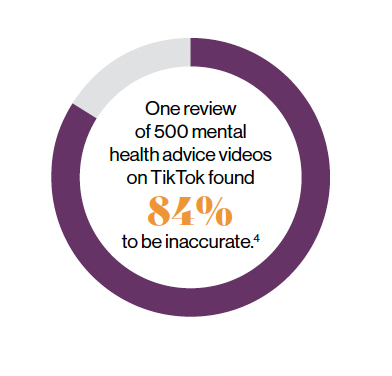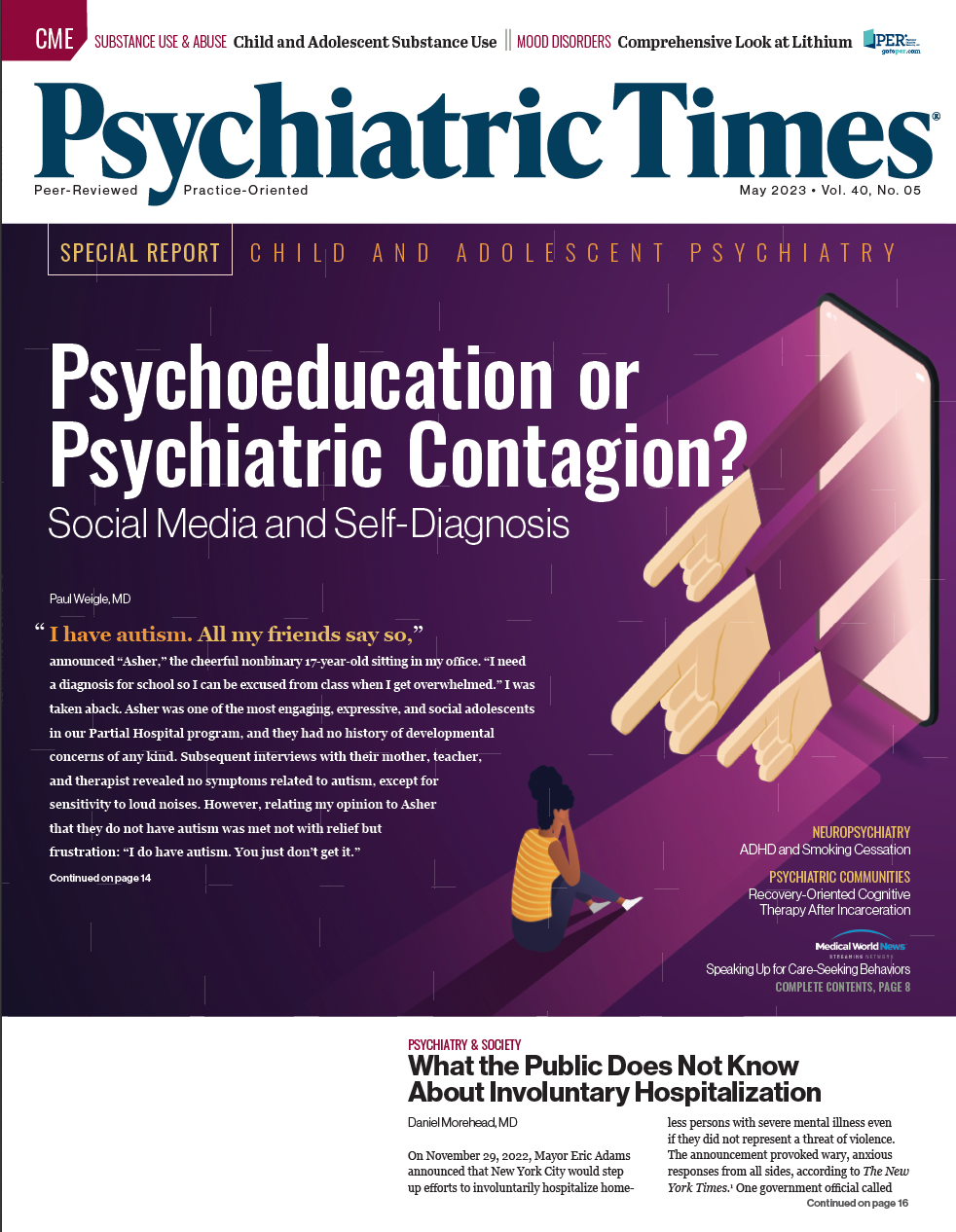
Publication
Article
Psychiatric Times
Psychoeducation or Psychiatric Contagion? Social Media and Self-Diagnosis
Author(s):
"I have autism. All my friends say so. I do have autism. You just don't get it."
bbk22/AdobeStock

SPECIAL REPORT: CHILD AND ADOLESCENT PSYCHIATRY
"I have autism. All my friends say so,” announced “Asher,” the cheerful nonbinary 17-year-old sitting in my office. “I need a diagnosis for school so I can be excused from class when I get overwhelmed.” I was taken aback. Asher was one of the most engaging, expressive, and social adolescents in our Partial Hospital program, and they had no history of developmental concerns of any kind. Subsequent interviews with their mother, teacher, and therapist revealed no symptoms related to autism, except for sensitivity to loud noises. However, relating my opinion to Asher that they do not have autism was met not with relief but frustration: “I do have autism. You just don’t get it.”
Social Media: Chronically Online?
Humans are social beings. The complexity of our relationships can be credited for much of our success as a species. Organization into tribal groups allowed our ancestors to coordinate defense and delegate vital tasks such as hunting and care of the young. Understanding one another was necessary for effective competition for mates and resources. Social thinking is perhaps most relevant for adolescents—typically preoccupied with how they are perceived and valued by peers. A vital ingredient in socializing is imitation. Replicating the behaviors of others allows individuals to assimilate into groups and adopt customs and behaviors needed to perform important tasks or avoid dangers. Social imitation is not unique to humans, but it is necessary for the evolving culture which, accumulating over generations, allowed our ancestors not only to survive, but to progress from hunting and gathering toward modern civilization.1
Social media platforms such as TikTok and Snapchat take advantage of adolescents’ innate need to interact, particularly in an age in which they live apart. One developmental task of adolescence is experimenting with identity, an activity that social media facilitates effectively: allowing teens unprecedented control over self-presentation and circumventing the effort and complications required to meet physically. It is little wonder that social media engagement among adolescents skyrocketed during recent years, to average 87 minutes per day.2 Distressed youth typically go online for information and help.3 Many learn about psychiatric disorders via popular social media posts, although the veracity of such videos is generally poor. One review of 500 mental health advice videos on TikTok found 84% to be inaccurate.4

Most adolescents attempt to influence peers on social media by making themselves seem as attractive as possible, often by using photo filters and other means to carefully craft posts. However, a social media subculture appears to have formed around the role of mental illness.5 Embracing an identity of illness has several potential benefits. It can generate the interest and support of peers, lionize the sufferer as heroic, and facilitate affiliation with a like-minded peer group, possibly a preferred group (eg, one perceived as an oppressed minority).6 Identification with a psychiatric diagnosis can justify the teen’s distress or failures, and it can provide an excuse from unwanted responsibilities such as going to school or doing chores. Teens often play the role of therapist or caretaker to one another online, making the purported illness the basis for a valued relationship. Therefore, some adolescents may be very invested in being mentally ill, or suffering a specific diagnosis, even despite evidence to the contrary. A physician’s confirmation can be validating. Overidentification with a diagnosis can risk creating a self-defeating thought process and behaviors, as individuals may be reticent to give up the sick role or assume that healthy behaviors are doomed to fail.
Social Contagion: The Online Spread
Based on the idea of biological contagion, social contagion is the process by which information, behaviors, or attitudes spread among individuals in close contact. Traditionally, this has occurred only among individuals living in close proximity, but media has made contagion possible among those who are distant. Goethe’s popular 1774 novel, “The Sorrows of Young Werther,” in which the protagonist commits suicide as a solution to unrequited love, was implicated in a string of suicides of young readers in Europe. Television reporting of suicide has been implicated in widespread contagion, as was “13 Reasons Why,” the streaming series that first aired in 2017.7
Social media appear to have the potential to spread mental health contagion on an unprecedented scale. Limited research evidence for contagion via social media has been documented for tics,8 eating disordered behavior,9 self-harm,10 suicidality,11 and—controversially—gender dysphoria.12 Cases identified as psychiatric contagion are related to prominent impairment of functioning in a manner analogous to conversion disorder.
In clinical practice, adolescent females may be most likely to present with a self-diagnosis. The most common inaccurate self-diagnoses include dissociative identity disorder, bipolar disorder, autism, and attention-deficit/hyperactivity disorder (ADHD). In my poll of more than 100 attendees at a social media institute at the American Academy of Child & Adolescent Psychiatry’s annual meeting, 74% of respondents reported that they somewhat often or very often see patients who seem to believe they suffer from a psychiatric or neurological condition because of what they saw online. About 80% of respondents indicated they somewhat often or very often see teens who seem to be influenced by social media in regard to their sexual and/or gender identity.
When a patient presents with a self-diagnosis, our first step should be to assess their concerns using an inquisitive, open-minded approach. We may ask how they learned about the diagnosis, and then review any related symptoms, what exacerbates or relieves them, and ascertain impact on their daily functioning. Asking directly what the diagnosis means to the patient may be helpful. We can also inquire whether they have friends who suffer from the same condition, and how friends respond to the patient’s symptoms. It may help to ask to coview their social media feeds to assess any mental health content the patient relates to. It is vital to obtain collateral information about the patient’s symptoms and ascertain whether perspectives of teachers, family, and therapists align. If not, we may wonder what psychological or functional need of our patient is served by identifying with this diagnosis.
If we determine the patient has self-diagnosed incorrectly, we must share this perspective with the patient while avoiding unnecessary conflict. We should validate the patient’s genuine distress and help them make better sense of it, perhaps by emphasizing a biopsychosocial understanding and deemphasizing diagnosis. We can help the patient see that many aspects of life provide identity: neighborhood, school, cultural group, personal strengths, beliefs, and interests. Even an accurate diagnosis must not define the individual.
Concluding Thoughts
As clinicians, we can and should help all patients pursue healthy ways to address unmet psychological needs, including these patients influenced by social media. For example, if a patient reports online ruminations about depression function to garner social support, we may encourage that patient to meet this need elsewhere, such as engaging in team sports or after-school activities that provide social opportunities, or arranging in-person recreational time with a peer or family member. For adolescents whose social media involvement appears excessive, scheduled breaks may be helpful, such as implementing a new practice of removing screen media from the bedroom or moving the screens to another room during family dinner or homework. In cases in which online access threatens safety or severely impairs functioning, we may consider advising parents to remove internet access entirely for a limited time as a last resort, while also preparing for the contingency that doing so may provoke a crisis, as may be the case for patients who are psychologically dependent on social media connection.
The internal lives of adolescents are increasingly influenced by social media interactions, and it is the responsibility of mental health practitioners to incorporate an understanding of this process into assessment and treatment. We must be influencers of a different kind.
Dr Weigle is associate medical director at Natchaug Hospital of Hartford Healthcare and assistant professor of psychiatry at UConn School of Medicine. He serves as cochair of the American Academy of Child & Adolescent Psychiatry’s media committee, and on the National Scientific Advisory Board of the Institute of Digital Media and Child Development. He lives in Mystic, Connecticut, with his wife and 2 teenaged social media enthusiasts.
References
1. Henrich J, Muthukrishna M. The origins and psychology of human cooperation. Annu Rev Psychol. 2021;72:207-240.
2. Rideout V, Peebles A, Mann S, Robb MB. The Common Sense census: media use by tweens and teens, 2021. Common Sense. 2022. Accessed February 16, 2023. https://www.commonsensemedia.org/sites/default/files/research/report/8-18-census-integrated-report-final-web_0.pdf
3. Pretorius C, Chambers D, Cowan B, Coyle D. Young people seeking help online for mental health: cross-sectional survey study. JMIR Ment Health. 2019;6(8):e13524.
4. How accurate is mental health advice on TikTok? PlushCare. November 18, 2022. Accessed February 16, 2023. https://plushcare.com/blog/tiktok-mental-health/
5. Harness J, Getzen H. TikTok’s sick-role subculture and what to do about it. J Am Acad Child Adolesc Psychiatry. 2022;61(3):351-353.
6. Lembke A. Drug Dealer, MD: How Doctors Were Duped, Patients Got Hooked, and Why It’s So Hard to Stop. Johns Hopkins University Press; 2016:98.
7. Bridge JA, Greenhouse JB, Ruch D, et al. Association between the release of Netflix’s 13 Reasons Why and suicide rates in the United States: an interrupted time series analysis. J Am Acad Child Adolesc Psychiatry. 2020;59(2):236-243.
8. Samuels MA. Tik Tok tics. Am J Med. 2022;135(8):933-934.
9. Chung A, Vieira D, Donley T, et al. Adolescent peer influence on eating behaviors via social media: scoping review. J Med Internet Res. 2021;23(6):e19697.
10. Lewis SP, Seko Y. A double-edged sword: a review of benefits and risks of online nonsuicidal self-injury activities. J Clin Psychol. 2016;72(3):249-262.
11. Swedo EA, Beauregard JL, de Fijter S, et al. Associations between social media and suicidal behaviors during a youth suicide cluster in Ohio. J Adolesc Health. 2021;68(2):308-316.
12. Littman L. Parent reports of adolescents and young adults perceived to show signs of a rapid onset of gender dysphoria. PLoS One. 2018;13(8):e0202330. Published correction appears in PLoS One. 2019;14(3):e0214157.

2 Commerce Drive
Cranbury, NJ 08512
All rights reserved.





